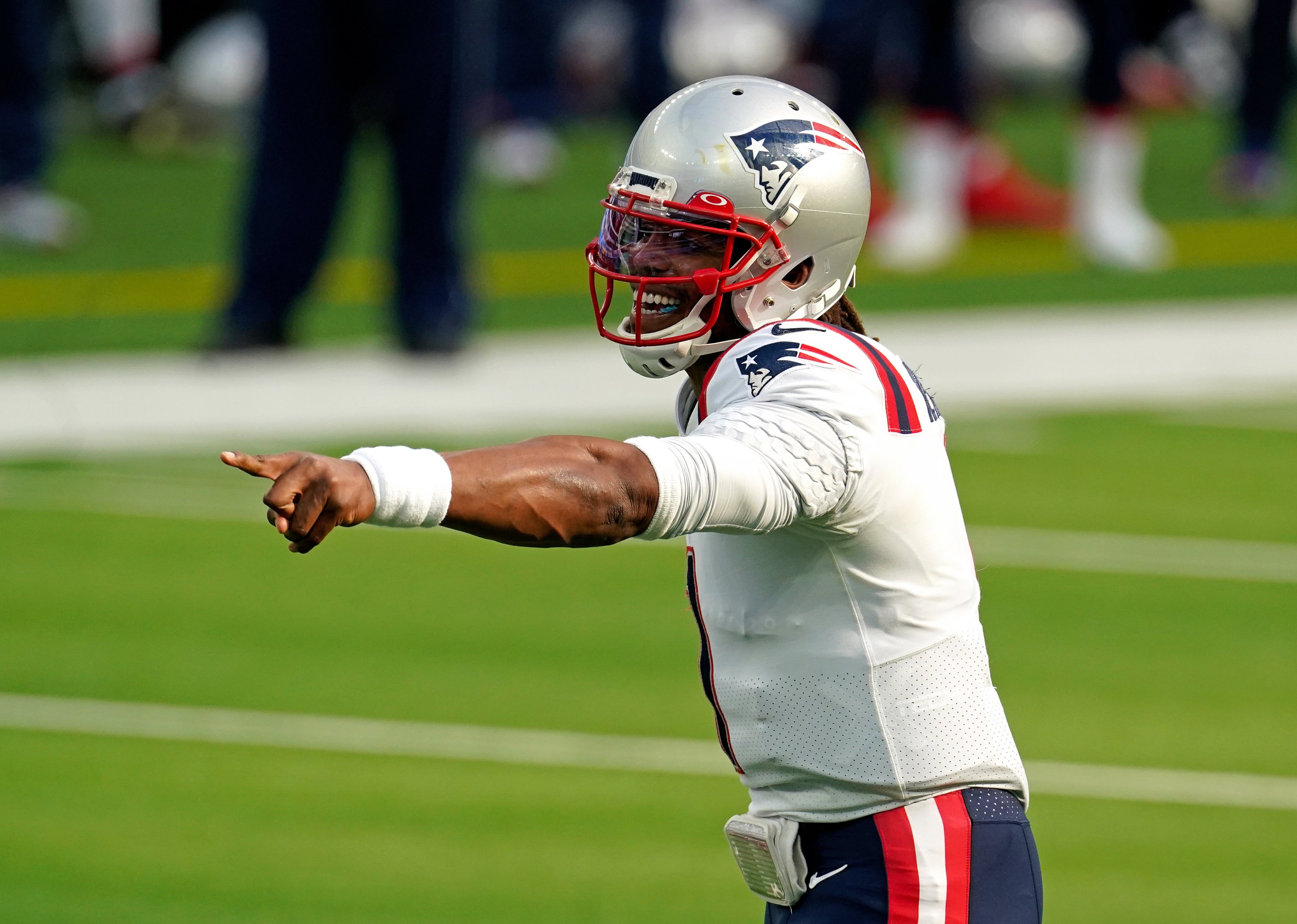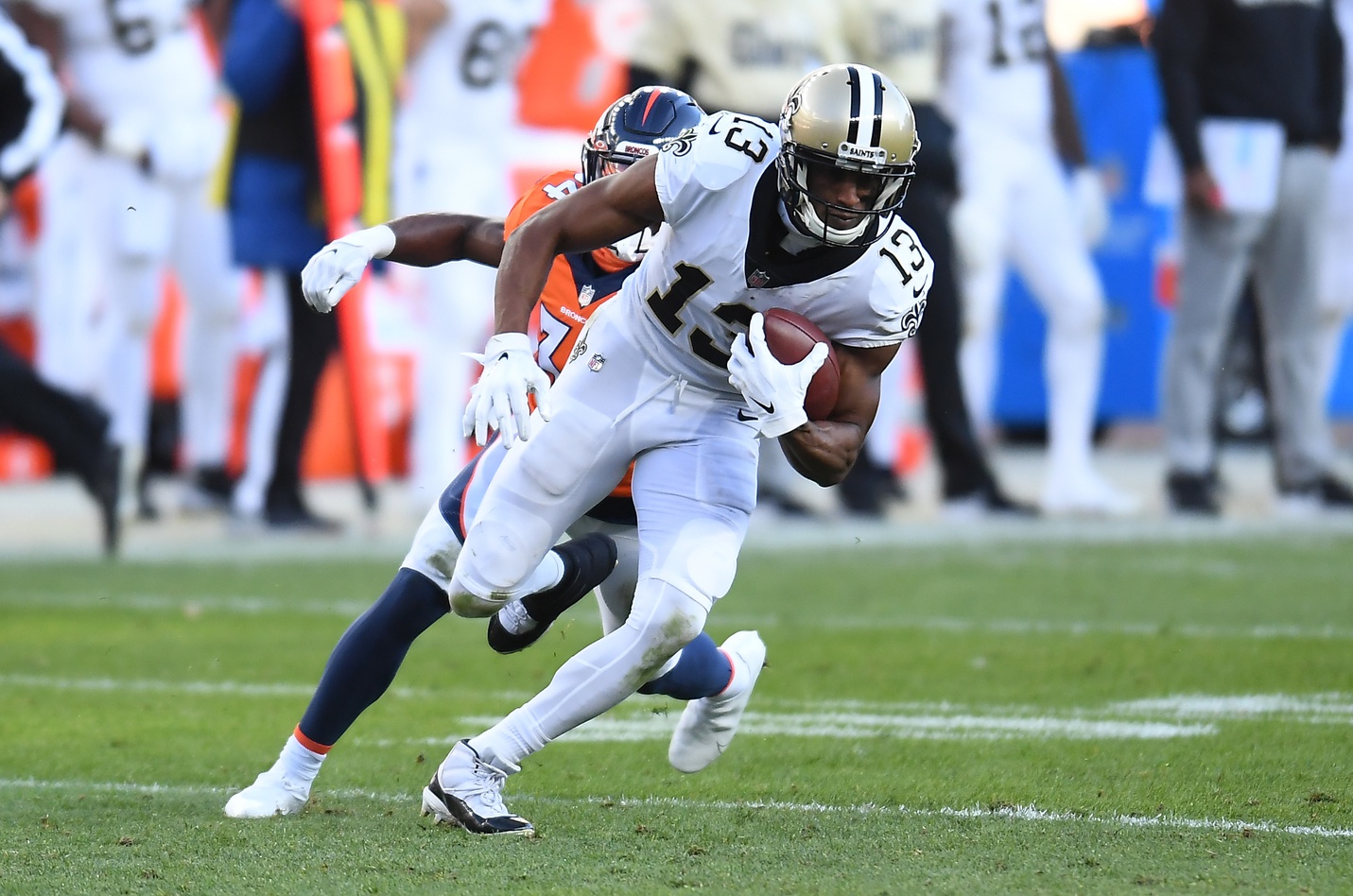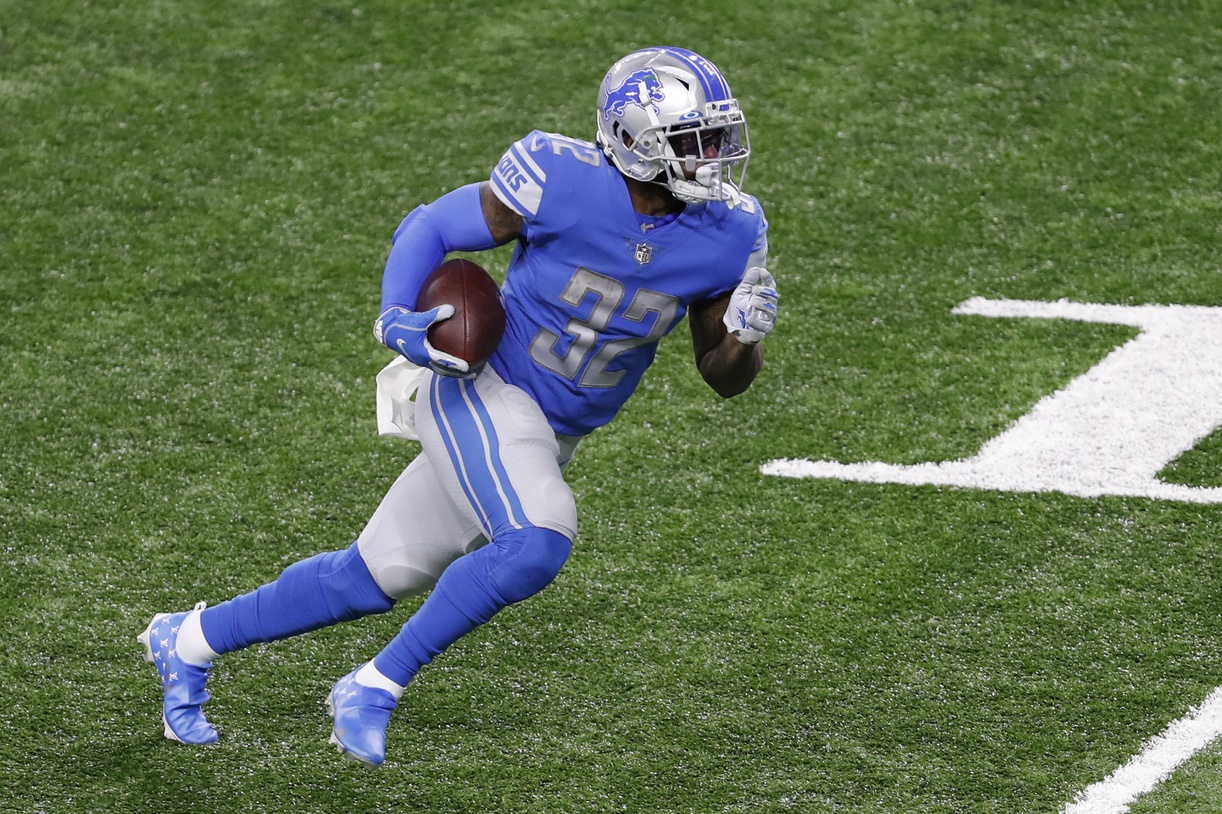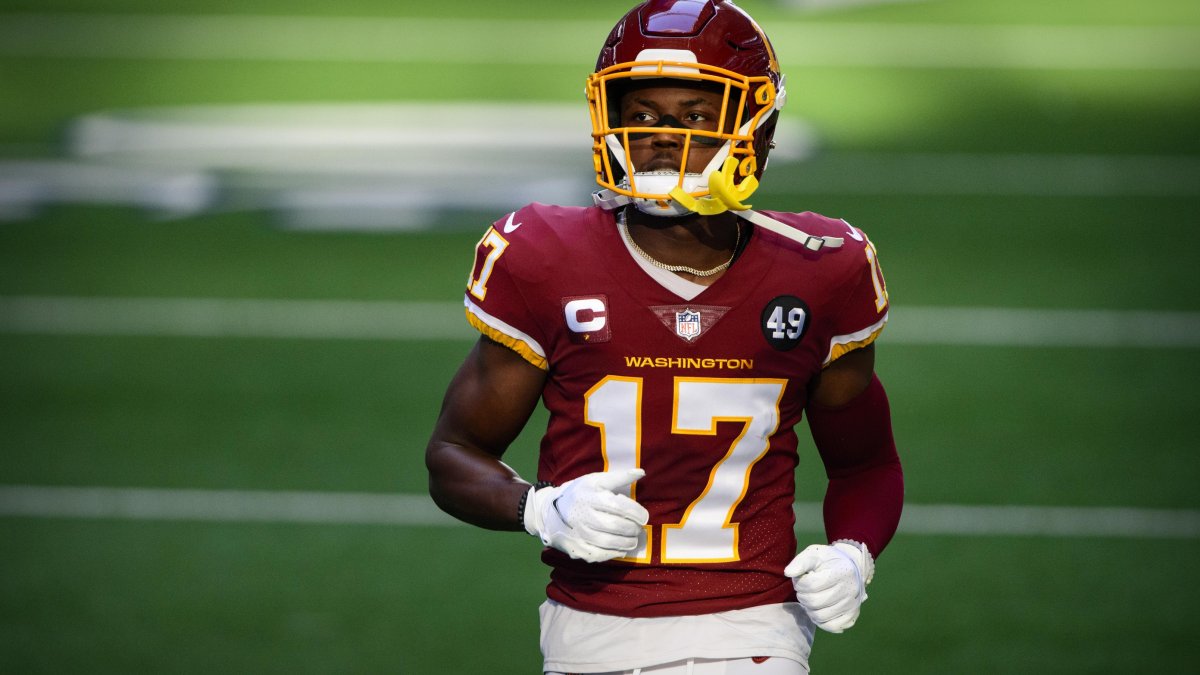The 2021 version of NFL free agency has not disappointed. The New England Patriots kicked things off with a flurry of transactions over the past few days. We've seen deals ranging from savvy under-the-radar signings to huge splashes by teams trying to get back into playoff contention.
So much player movement has created massive implications across the fantasy football landscape, with values rising and falling faster than ever. PFF's Ian Hartitz has done a great job keeping up with all the news and its fantasy impact in PFF’s Fantasy Football Free Agent Tracker.
Now it's time to hit on the big fantasy football winners from the last few days of NFL free agency. The following players have seen their values increase since the start of the week. I’ll also touch on some players who may have seen their stock wrongly fall due to perceived narratives. Negative buzz can create an opportunity to acquire these players at a discount, making them winners in my book.
And before I forget: A.J. Brown isn’t featured here because I already sung his praises in my fantasy fallout piece on Corey Davis. AJB is a no-doubt top-five fantasy receiver in 2021 with 120-plus targets coming in hot.
CAM NEWTON, NEW ENGLAND PATRIOTS
When Cam Newton first re-signed with the Patriots, I thought he could become a top-12 fantasy QB if the team added more offensive pieces around him. Lo and behold, the New England Patriots did just that by adding two premier tight end options to Cam’s offensive arsenal in Jonnu Smith and Hunter Henry.
Newton has a strong track record of targeting big bodies at the TE position during his days in Carolina throwing to Greg Olsen (top-10 in targets), Devin Funchess (played TE in college) and Kelvin Benjamin (built like a TE). The new additions will replace second-year tight ends Dalton Keene and Devin Asiasi and should be huge for Newton’s fantasy ceiling.
These mismatch-creating tight ends cater perfectly to what Newton did well as a passer last season. Per PFF’s QB Annual, the Patriots’ quarterback was above average in accuracy from 10-19 yards downfield. Newton posted a 63% completion rate on those intermediate throws — identical to Aaron Rodgers and Josh Allen. His yards per attempt (10.8) ranked top 10.
Henry (92.8) and Smith (92.0) both boast top-10 PFF grades when targeted in the 10-19 yard range since 2019.
Belichick added key playmakers who should accentuate his quarterback’s strengths. And the additions didn’t stop at tight end.

The Patriots also signed wide receivers Kendrick Bourne and Nelson Agholor. Bourne figures to be used mostly as a red-zone weapon and at the intermediate level.
The former San Francisco 49ers wide receiver finished 2020 with a 90.8 PFF receiving grade on targets 10-19 yards downfield, which ranked 20th at the position. He also ranks second among all WRs in passer rating generated (119.4) on targets inside the 10-yard line since 2018.
Agholor projects to take over the field-stretcher role vacated by Damiere Byrd. Last season, Agholor finished second in the league in yards per reception (18.7) and sixth in total deep-ball yards (444).
His total deep-ball yardage in 2020 exceeded that of all the Patriots WRs and TEs combined (439). Agholor provides an immediate upgrade as a deep threat for Newton, who can still throw downfield despite what naysayers might argue.
Newton’s adjusted completion percentage on passing attempts 20-plus yards downfield ranked sixth-best in the NFL last year (51.8%), only three spots lower than Agholor’s old quarterback, Derek Carr.
But Cam won’t just be throwing deep to Agholor in 2021. His new tight end Jonnu Smith owns PFF’s third-highest receiving grade (94.5) and second-highest passer rating generated (149.3) when targeted 15-plus yards downfield.
With Newton’s supporting cast upgraded seemingly overnight, it’s easy to see his path to fantasy success in 2020 considering his upside as a rusher. It’s just too bad the days of drafting him as the QB32 on Underdog Best Ball Drafts are long over.
TERRY MCLAURIN, WASHINGTON FOOTBALL TEAM
Ryan Fitzpatrick signed a one-year deal worth almost $10 million with the Washington Football Team and is expected to start ahead of Taylor Heinicke. This news is about as good as it gets for star wide receiver Terry McLaurin.
Allen Robinson is the most widely known receiver who has suffered from poor quarterback play over the years, but we really need to view McLaurin in a similar fashion.
Since entering the league in 2019, F1 has caught passes from Heinicke, Case Keenum, Dwanye Haskins, Colt McCoy, Alex Smith and Kyle Allen.
Outside of Heinicke, none have managed even a 67.0 PFF passing grade over the past two seasons. And his 89.8 PFF passing grade from 2021 is based on just a two-game sample.
Still, McLaurin has produced despite the inconsistent quarterback play. He ranks 13th in PFF receiving grade (85.4) from 2019-2020 and has averaged over 1,000 receiving yards in back-to-back seasons. McLaurin also finished last year 11th in expected fantasy points per game.
He also met a certain statistical threshold I've used to predict incoming “boom” seasons. McLaurin has ranked top 12 in both aDOT and YAC/reception. Other players who have done so: Calvin Ridley, Kenny Golladay, Stefon Diggs, Chris Godwin and Tyreek Hill.
What McLaurin has been able to accomplish has been remarkable, but Fitzmagic raises his fantasy ceiling substantially.
There wasn't really much ceiling attached to McLaurin previously, because his QBs wouldn't — or couldn't — push the ball downfield. Every WFT quarterback not named Heinicke finished outside the top 48 QBs in aDOT in 2020. The offense was built around checkdowns to J.D. McKissic.
Since the start of the 2018 season, Fitzpatrick ranks fourth in the NFL in aDOT (9.7). We also know Fitzpatrick offers a gunslinger mentality that ensures No. 1 receivers are peppered with targets — regardless of whether they're open or not. Per PFF’s 2021 QB Annual, 24% of Fitzpatrick’s throws were into tight windows — the highest rate in the league.
McLaurin’s PFF receiving grade (94.7) and passer rating generated (118.8) on 20-plus throws rank seventh-best in the league since 2019. One of the few receivers that ranks ahead of him is Miami Dolphins receiver DeVante Parker, who famously became a top-two fantasy WR with Fitzpatrick under center over the second half of 2019.
Prepare to add McLaurin to the list of WRs destined to take the next step thanks to Fitzmagic.
Ryan Fitzpatrick's No. 1 WR has the following target totals in his eight seasons with 10+ starts:
???? T.J. Houshmandzadeh: 137
???? Stevie Johnson: 148, 141, 134
???? Andre Johnson: 146
???? Brandon Marshall: 173, 128
???? DeVante Parker: 128 pic.twitter.com/Z8AedLK3bh— PFF Fantasy Football (@PFF_Fantasy) March 16, 2021
CURTIS SAMUEL, WASHINGTON FOOTBALL TEAM
It’s impossible to name McLaurin as a big winner in free agency without also including new teammate Curtis Samuel in the same category. The former Carolina Panthers wide receiver signed a three-year contract on Wednesday worth $34.5 million with the Washington Football Team, per Adam Schefter.
Samuel will reunite with head coach Ron Rivera and offensive coordinator Scott Turner in the nation’s capital. Under Turner’s regime in the final four games of the 2019 season, Samuel was showcased in the running game with nine rushing attempts for 44 yards. Last season, Samuel led all WRs in rushing attempts (41) and rushing yards (200).
He also earned a career-high PFF grade (77.0) and finished Weeks 7-17 as the WR12 overall in fantasy football (16.9 fantasy points per game). Even in a crowded receiving room with both Robby Anderson and D.J. Moore, Samuel was able to carve out a solid role in a new offense.
A huge reason why Samuel broke out in 2020 was his increase of accurate passes thrown his way. After finishing the 2019 season 79th in catchable target rate (60%), Samuel finished No. 1 overall in catchable target rate in 2020 (86%).
Seeing a reduced aDOT (14.8 versus 7.5) and higher slot snap rate (29% versus 71%) also made it easier for Samuel to command more accurate targets, but there’s no debate that Teddy Bridgewater’s overall precision passing — third in NFL in adjusted completion percentage (80%) — was critical.
Per PFF’s 2021 QB Annual, Fitzpatrick finished the 2020 season second-best in accuracy-plus percentage, a metric that considers the ball placement of a throw relative to the receiver (in front of the receiver, behind the receiver, etc.).
With McLaurin and tight end Logan Thomas his main competition for targets/touches in the 2021 WFT offense, it’s hard not to be giddy about Samuel’s fantasy prospects in a more featured role.
I anticipate that Samuel will get his fair share of downfield looks — No. 1 deep-ball catch rate in 2020 (77%) — but predominantly reprise his role from 2020 operating from the slot and at the short-to-intermediate level of the field.
Curtis Samuel's deep-ball catch %
???? 2019: 18.5% (89th)
???? 2020: 77.0% (1st) pic.twitter.com/UDAO6FVRvp— PFF Fantasy Football (@PFF_Fantasy) March 12, 2021
WR/RB hybrid J.D. McKissic saw 100-plus targets last season — most among all RBs — and those opportunities look ripe to be cannibalized by the Football Team’s newest dynamic playmaker.
MICHAEL THOMAS, NEW ORLEANS SAINTS
The 2020 season was a year to forget for the 2019 overall WR1. Michael Thomas was banged up with injuries, his quarterback’s arm fell off and he became a mockery on social media with the nickname “Slant Boy.”
But not everything was horrible for Thomas in 2020 — he had a nice stretch from Weeks 10-14 when he commanded a 32% target share and earned an 88.3 PFF receiving grade.
Thomas also averaged 2.53 yards per route run, which practically matches his career average (2.45). He should be applauded for accomplishing such feats considering the team's lackluster QB play.

Thomas is a screaming value heading into 2021 with Jameis Winston back in the fold as the odds-on favorite to take over in New Orleans. Winston’s arm talent alone gives Thomas more upside than he would have with Drew Brees under center for another year.
Brees finished as the league's 23rd-ranked passer, and his average depth of target (6.5) fell to the lowest of his career. Winston holds the league’s highest aDOT since 2019. Bombs away.
And even if Taysom Hill ends up winning the job, that just means a more concentrated target share for Thomas. In Hill’s four starts, Thomas owned a 33% target share, a 90.5 PFF receiving grade and averaged 2.86 yards per route run. He just didn’t score any TDs despite leading the team in targets inside the 10-yard line, which was the real reason behind his lackluster fantasy production.
MYLES GASKIN, MIAMI DOLPHINS
We had to sweat the possibility of a high-profile free-agent running back taking his talents to South Beach and torpedoing Gaskin's fantasy value, but things look OK so far.
With Aaron Jones re-signing with the Green Bay Packers and the Miami Dolphins electing to bring in a much less coveted running back in Malcolm Brown, Myles Gaskin gets a win.
Brown finished the 2020 season second-to-last (60th) in yards after contact per attempt (2.2) despite being a 220-pound supposed bruiser. Only Peyton Barber was worse in that metric.
Brown hardly presents much of a threat considering Gaskin already beat out established veterans who compare to Brown, like Matt Breida and Jordan Howard, last season.
The Miami coaching staff seems to love Gaskin — he was the featured back any time he was healthy and active throughout the 2020 season.
The Dolphins’ second-year runner missed time after contracting COVID-19 but slid right back into a starting role upon returning in Week 16, commanding a 75% snap share and 19 total touches.
From Weeks 1-17, he finished sixth in expected fantasy points per game (17.6) and 12th in fantasy points per game (16.8).
We still have a ways to go before we can proclaim Gaskin Miami’s No. 1 running back, but for now we can breathe a sigh of relief.
GERALD EVERETT, SEATTLE SEAHAWKS
Sometimes the process works, people! I recently wrote about tight end Gerald Everett being a screaming buy-low candidate in dynasty fantasy football leagues because I envisioned him signing with the Seattle Seahawks.
They had a need at the tight end position with Jacob Hollister (free agent) and Greg Olsen (retired) not returning, and Everett has an established relationship with new Seattle offensive coordinator Shane Waldron, who spent his last four seasons with the Los Angeles Rams.
I thought Everett was a late-round tight end who had breakout potential heading into 2020 after a career-year in 2019, but he never got the opportunity.
Now with the chance to emerge as the clear No. 3 pass-catching option attached to uber-efficient Russell Wilson (hopefully), Everett is shaping up to be one of my most heavily rostered late-round tight ends in 2021.
He finished seventh in yards after the catch per reception (5.9), which was better than Jonnu Smith last season. Everett’s missed tackle rate (25%) is the highest among all tight ends since the start of the 2018 season.
D’ANDRE SWIFT, DETROIT LIONS
The Detroit Lions added running back depth in free agency by inking Jamaal Williams to a two-year deal. The initial reaction from the fantasy football community seems to be that this is a hit to D’Andre Swift’s fantasy draft stock, but I'm not sure I agree.
There are only a select few elite running backs who don’t split snaps with a teammate to some extent. Projecting Swift to see a 60% snap share with Williams is hardly a strong reason to fade him.
Williams hovered around a 30% to 50% snap share with Green Bay last year, and that didn’t stop Aaron Jones from becoming a locked-and-loaded RB1 every week. Sure, it would have been nice for Jones to have seen a 90% snap share, but then his body might have broken down or he might have been less efficient.
Swift finished his rookie season 18th in RB points per game (14.9) despite seeing a 70-plus percent snap share only once. Even with Williams in the fold, Swift is going to be the clear touch and snap leader in the Lions’ backfield, which makes him worth buying at whatever ADP dip the Williams signing causes.

New head coach Dan Campbell and offensive coordinator Anthony Lynn come from offenses where their true RB1 wasn’t an every-snap player. Running backs Alvin Kamara and Austin Ekeler saw snap shares between 50% and 70% in 2020, which is the exact type of workload we can project for Swift in 2021.
Those concerned that Williams will eat into Swift’s pass-game usage shouldn’t be. Adrian Peterson (12) and Kerryon Johnson (19) combined for the same amount of receptions as Williams (31) last season.
Williams’ addition is a clear indication that both Peterson (free agent) and Johnson either won’t be back or won't play any type of integral role in the offense.
Swift isn’t a winner because of the Williams signing, but savvy fantasy gamers can take advantage of a potential discount on a second-year player with superstar potential.
GABRIEL DAVIS, BUFFALO BILLS
Gabriel Davis’ stans weren’t thrilled when the Buffalo Bills opted to sign veteran free agent Emmanuel Sanders to a one-year deal for 2021. It looked like it was wheels up for Davis as a breakout candidate in 2021 after the team released John Brown, but this new signing has people pumping the brakes.
I am not one of those people.
Davis' downfield archetype — 17.3 aDOT, seventh-highest in the NFL — is the complete opposite of Sanders’ recent usage. Even if we remove Sanders’ last season with the noodle-armed Drew Brees (all Saints receivers had low aDOTs), Sanders hasn’t posted an aDOT higher than 13.0 since 2016.
Entering his age 34-season, it’s fair to assume that Sanders doesn’t present a great threat to defenses vertically, so I’m not sweating his presence inhibiting Davis’ second-year breakout.
If anything, I’d say the Sanders addition might be more of a depth signing behind 32-year-old Cole Beasley, who dealt with a few injuries toward the end of the 2020 season. Beasley plays almost exclusively out of the slot, and Sanders would be a solid alternative there.
Sanders only has one season with an 80-plus PFF grade since 2017. It was in 2018, and he played more than 60% of his snaps from the slot that year.
The Bills are likely to leverage their top four wide receivers as often as possible by having them on the field at the same time. Last year, they finished second in 10-personnel usage (16%).
Buy the price dip on Davis.



 © 2025 PFF - all rights reserved.
© 2025 PFF - all rights reserved.